

Table of contents
- 5 Good Vegetable Neighbors
- 5 ideal herbal neighbors
- 5 decorative flower neighbors
With the right neighbors, you can ensure healthy pumpkin plants and a good harvest. So that you can create a mixed culture productively, 15 good neighbors are presented to you in this article.
5 Good Vegetable Neighbors
amaranth(Amaranthus caudatus)
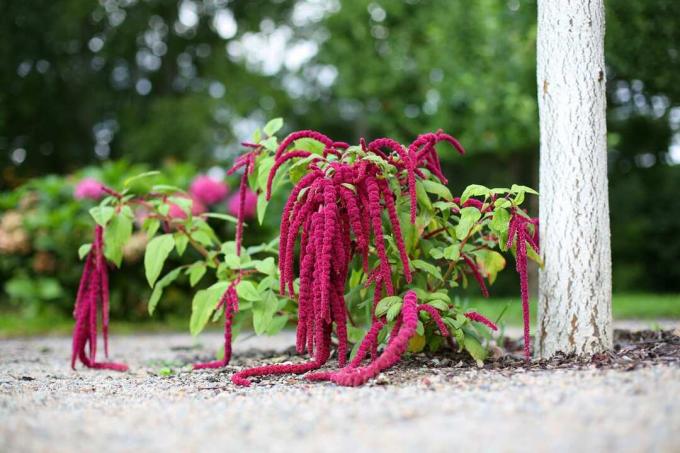
- Effects: protection against pests, possible climbing aid, protects soil from drying out
- Growth height: up to 150 cm
- Space requirement: 30 cm
- Light requirements: full sun to semi-shade
- Location and soil: sheltered from the wind, deep, loose, rich in nutrients, permeable
- Harvest time: Leaves all season (leaf vegetables), September to mid-October (seeds)
- medium eater
kidney bean(Phaseolus vulgaris)

- Effect: improves soil quality, supplies nitrogen
- Growth height: Pole beans 200 to 400 cm, French beans up to 60 cm
- Space requirement: 20 cm
- Light requirement: sunny
- Location and soil: warm, sheltered from the wind, humus, deep, loose
- Harvest time: about 10 weeks after planting
- Weak to medium eaters
Garlic(Allium sativum)
- Effect: protects against pests
- Growth height: 50 cm to 100 cm
- Space requirement: 15 cm to 20 cm
- Light requirement: sunny
- Location and soil: warm, sheltered from the wind, loose, humic, permeable
- Harvest time: from July
- medium eater
Corn(Zea mays)
- Effect: suitable as a climbing aid, improves soil quality
- Height of growth: 60 cm to 600 cm (depending on variety), mostly 150 cm to 250 cm
- Space requirement: 30 cm
- Light requirement: sunny
- Location and soil: deep, loose, rich in nutrients, permeable
- Harvest time: August to mid-October
- heavy feeder
radishes(Raphanus)
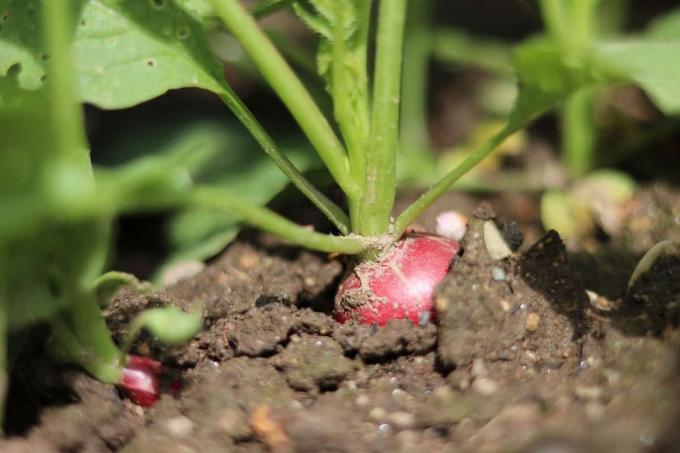
- Effect: protects against pests and weeds
- Growth height: depends on species
- Space requirement: 20 cm to 25 cm
- Light requirement: sunny
- Location and soil: moist, deep, loose, humic, well-drained, loamy
- Harvest time: 8 to 15 weeks after sowing (depending on species)
- Weak feeder or medium feeder (depending on species)
- Radishes are also included
A notice:
Pumpkins, along with corn and haricot beans, are part of the Mayan Milpa farming system. Known as the "Three Sisters", the species together have an ideal effect on each other's growth.
5 ideal herbal neighbors
lavender(lavandula)

- Effect: attracts pollinating insects
- Growth height: 30 cm to 100 cm
- Space requirement: 30 cm
- Light requirement: sunny
- Location and soil: warm, nutrient-poor, permeable
- Harvest time: July to August
- weak feeder
marjoram(Origanum majorana)

- Effect: improves pumpkin taste,
- Growth height: 50 cm to 100 cm
- Space requirement: 20 cm to 30 cm
- Light requirement: full sun
- Site and soil: humic, loose, nutritious, permeable
- Harvest time: summer to autumn
- weak feeder
oregano(Origanum vulgare)

- Effect: improves health, protects against vermin
- Growth height: 15 cm to 50 cm
- Space requirement: 20 cm to 30 cm
- Light requirements: sunny to semi-shady
- Location and soil: warm, calcareous, sandy, poor in nutrients, permeable
- Harvest time: May to the end of the season
- weak feeder
peppermint(Mentha piperita)

- Effect: protects against pests
- Growth height: up to 100 cm
- Space requirement: 30 cm
- Light requirement: light shade to semi-shade
- Site and soil: humic, loamy, sandy, nutritious, well-drained, fresh and moist
- Harvest time: mid-May to early October
- medium eater
hyssop(Hyssopus)
- Effect: attracts pollinating insects and beneficial insects, protects against pests
- Growth height: 20 cm to 80 cm
- Space requirement: 30 cm to 40 cm
- Light requirement: sunny
- Location and soil: sheltered from the wind, permeable, calcareous, dry
- Harvest time: June to August
- medium eater
Tip:
Also offers itself as tansy (Tanacetum vulgare) as a good neighbor. Wormwort is effective against numerous lice and even repels mosquitoes and other biting insects.
5 decorative flower neighbors
camomiles(matricaria)
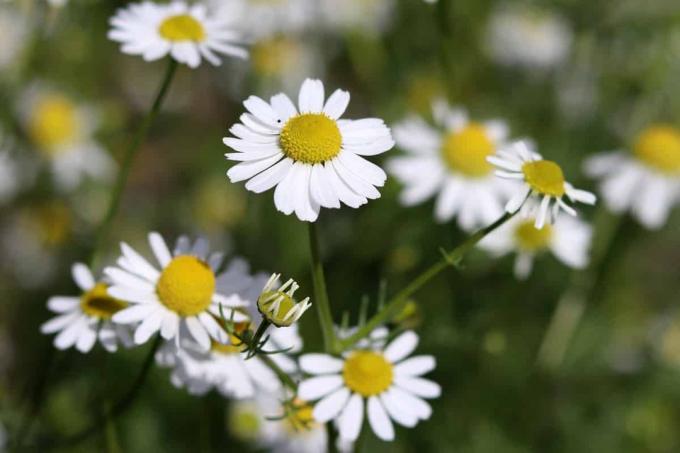
- Effect: improve soil quality, absorbs lime from the soil, attracts pollinating insects
- Growth height: 50 cm to 60 cm
- Space requirement: 15 cm to 30 cm
- Light requirements: sunny to semi-shady
- Site and soil: deep, dry, undemanding
- flowers can be used (e.g. for tea)
- weak feeder
Nasturtiums(Tropaeolum)

- Effect: protects against pests, attracts pollinating insects
- Growth height: 20 cm (without tendrils), up to 300 cm (tendrils)
- Space requirement: depends on growth form
- Light requirements: sunny (prefers), tolerates shade
- Site and soil: sheltered, loamy, sandy, moderately humic
- Leaves, flowers and seeds usable and edible
- weak feeder
marigold(Calendula officinalis)

- Effect: growth-promoting, improves pumpkin taste
- Growth height: 30 cm to 80 cm
- Space requirement: 15 cm
- Light requirement: sunny
- Site and soil: moderately moist, nutrient-rich, calcareous, sandy, loose
- Harvest time: Leaves all season (leafy vegetables), June to mid-October (flowers)
- weak feeder
sunflower(Helianthus annuus)

- Effect: Climbing aid, attracts pollinating insects
- Growth height: 150 cm to 300 cm
- Space requirement: 50 cm
- Light requirement: full sun
- Site and soil: nutrient-rich, moderately heavy, moist, nutrient-rich
- Harvest time: from mid-September, about a week after the flowers have withered
- heavy feeder
marigold(tagetes)
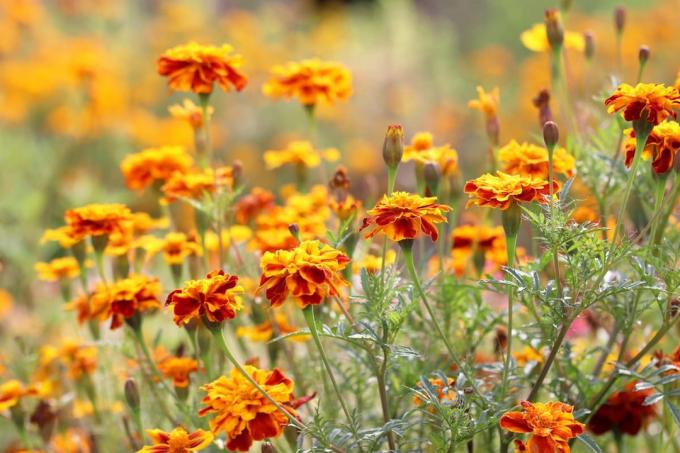
- Effect: protects against pests and parasites, improves soil conditions, protects against weeds
- Growth height: 20 cm to 110 cm (depending on species)
- Required space: 15 cm to 30 cm (depending on species)
- Light requirements: sunny to semi-shady
- Location and soil: sandy, loose, loamy, humic
- Harvest time: Leaves all season (leafy vegetables), flowers (June to mid-October), seeds after flowering
- weak feeder
A notice:
Bad pumpkin neighbors include dill, cucumber, zucchini, and potato. They have a negative effect on root growth and the vitality of the pumpkin plants.
 Home editorial office
Home editorial office
Learn more about pumpkins

Zucchini fruits rot on the plant: what to do?
Sometimes a young zucchini fruit suddenly stops growing. At the same time it becomes yellow and rotten from the top. Read here how you can save your harvest if the fruits of your zucchini are rotting on the plant.

Harvesting butternut squash: when is it ripe?
Rich yellow flesh and a pear-like shape characterize the butternut squash. If you have enough space for the fast-growing plants, you will be rewarded with many tasty fruits. When is the butternut squash ready for harvest?
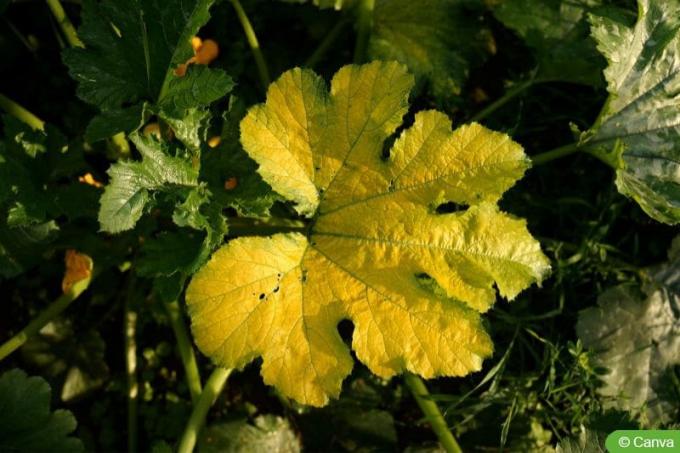
Yellow leaves on zucchini: what to do?
Zucchini planted in the garden usually develop so luxuriantly that there is often a veritable glut of zucchini. However, if the zucchini gets yellow leaves, you should consider location, care and diseases as causes and act immediately.

Zucchini: remove male flowers?
Zucchini form female and male flowers on one plant. The male flowers are important for pollination and thus fruit formation. The question often arises as to what the advantages and disadvantages are after removing the flowers.

Grow your own luffa cucumber 9 tips for the sponge gourd
Although the luffa cucumber comes from the tropics, it can also be grown locally. However, the sponge gourd is dependent on certain conditions when it comes to location and care, with these tips you will have a rich harvest.

How to Freeze Pumpkin | 4 tips so that it does not become bitter
Pumpkin season begins in the fall. If you want to enjoy pumpkin beyond that, you can freeze it for a longer shelf life. So that it doesn't taste bitter after defrosting, you need to pay attention to a few details that are explained in the guide.



